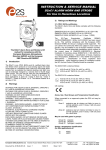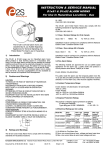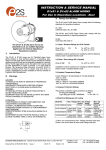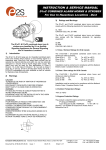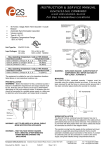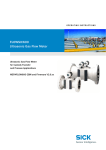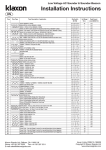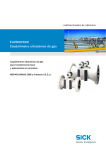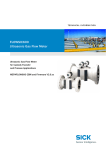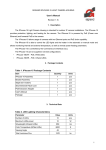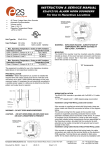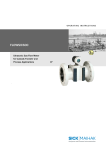Download INSTRUCTION & SERVICE MANUAL
Transcript
INSTRUCTION & SERVICE MANUAL D2xS1 ALARM HORN For Use In Hazardous Locations 3) Ratings and Markings 3.1 ATEX / IECEx certification The D2xS1 alarm horn complies with the following standards:EN60079-0:2012 / IEC60079-0: ed. 6.0 (2011-06) EN60079-15:2010 / IEC60079-15: ed. 4.0 (2010-01) EN60079-31:2009 / IEC60079-31:2009 ed. 1.0 (corr. 1 2009) The D2xS1 alarm horn is CE marked for compliance with the European Explosive Atmospheres Directive 94/9/EC and the European EMC Directive 89/336/EEC 1) Introduction The D2xS1 is an ATEX, IECEx and UL certified alarm horn which produces a loud warning signal in a hazardous area. Sixty-Four first stage alarm sounds can be selected by internal switches and each one can be externally changed to a second, third or fourth stage alarm sound. The alarm horn may be used for Gas applications in Zone 2 / Class I Zone 2 / Class I, Division 2 as well as for Dust applications in Zone 22 / Class II Zone 22 / Class II Division 2 / Class III Division 1 & 2. A D2xC1 combined alarm horn & strobe is also available. 2) The Type Examination Certificate DEMKO 14ATEX4786493904X / IECEx ULD14.0004X has been issued by UL. This confirms compliance with the European ATEX Directive 94/9/EC for Group II, Category 3G/D equipment. The alarm horn carries the Community Mark and subject to local codes of practice, may be installed in any of the EEA member countries. This instruction sheet describes installations which conform to the current issue of EN60079-14/IEC60079-14 Electrical Installation in Hazardous Areas; EN60079-10-1 / IEC 60079-10-1 Explosive Atmospheres - Classification of Areas. Explosive Gas Atmospheres; EN60079-10-2 / IEC 60079-10-2 Explosive Atmospheres - Classification of Areas. Explosive Dust Atmospheres. When designing systems for installation outside the UK, the local Code of Practice should be consulted. The D2X Alarm horn is rated as follows: II 3G II 3D Ex nA IIC T4 Gc (Ta -40ºC to +50ºC) Ex tc IIIC T90ºC Dc (Ta -40ºC to +50ºC) CE Marking Warnings SUITABLE FOR USE IN CLASS II, DIVISION 2, GROUPS A, B, C AND D HAZARDOUS LOCATIONS SUITABLE FOR USE IN CLASS II, DIVISION 2, GROUPS E, F AND G HAZARDOUS LOCATIONS WARNING: DO NOT OPEN WHEN EXPLOSIVE ATMOSPHERE IS PRESENT WARNING – EXPLOSION HAZARD – SUBSTITUTION OF ANY COMPONENT MAY IMPAIR SUITABILITY FOR CLASS I, DIVISION 2. WARNING – EXPLOSION HAZARD – SUBSTITUTION OF ANY COMPONENTS MAY IMPAIR SUITABILITY FOR CLASS II, DIVISION 2. POTENTIAL ELECTROSTATIC CHARGING HAZARD – CLEAN ONLY WITH A DAMP CLOTH USE HEAT RESISTANT CABLES AND CABLE GLANDS (RATED 90ºC OR HIGHER) EXPLOSION HAZARD. DO NOT REMOVE OR REPLACE LAMPS, FUSES OR PLUG-IN MODULES UNLESS POWER HAS BEEN DISCONNECTED OR THE AREA IS KNOWN TO BE FREE OF IGNITIBLE CONCENTRATIONS OF FLAMMABLE GASES OR VAPORS. EXPLOSION HAZARD. DO NOT DISCONNECT WHILE THE CIRCUIT IS LIVE OR UNLESS THE AREA IS KNOWN TO BE FREE OF IGNITIBLE CONCENTRATIONS. Zones, Gas / Dust Groups and Temperature Classification When connected to an approved system the D2X alarm horn may be installed in: Zone 2 explosive gas air mixture not likely to occur in normal operation, and if it does, it will only exist for a short time. Zone 22 explosive dust air mixture not likely to occur in normal operation, and if it does, it will only exist for a short time. May be used with gases in groups: Group IIA Group IIB Group IIC propane ethylene hydrogen / acetylene Having a temperature classification (for Gas applications) of: T1 T2 T3 T4 450ºC 300ºC 200ºC 135ºC May be used with Dust types: Group IIIA combustible flyings Group IIIB non-conductive dust Group IIIC conductive dust __________________________________________________________________________________________________________________ European Safety Systems Ltd. Impress House, Mansell Road, Acton, London W3 7QH [email protected] Tel: +44 (0)208 743 8880 www.e-2-s.com Fax: +44 (0)208 740 4200 Document No. D189-00-001-IS Issue: 7 18-06-15 Sheet 1 of 7 Maximum Surface Temperature for Dust Applications: 3.7 Electrical Ratings 90ºC Part No. Nominal Voltage Nominal Current Voltage Range D2xS1DC024 24Vdc 313mA 10-30Vdc D2xS1DC048 48Vdc 181mA 38-58Vdc D2xS1AC115 115Vac 89mA D2xS1AC230 230Vac 52mA 3.2 Class / Zone ratings US The D2xS1 alarm horn complies with the following standards: ANSI/UL 60079-0-2013 ANSI/UL60079-15-2013 ISA60079-31-2013 The D2X Alarm horn is rated as follows: Class I, Zone 2 Zone 22 AEx nA IIC T4 Gc (Ta -40ºC to +50°C) AEx tc IIIC T90°C Dc (Ta -40ºC to +50°C) 115Vac +/-10% 60Hz 230Vac +/-10% 50Hz Max Current 313mA @ 24Vdc 218mA @ 48Vdc 91mA @ 126.5Vac 72mA @ 253Vac Installation must be carried out in compliance with the National Electric Code. 4) 3.3 Class / Zone ratings Canada Special Condition for safe Use as stated on the Type Examination Certificate DEMKO 14 ATEX 4786493904X / CoC IECEx ULD 14.0004X: Special Conditions for Safe Use The D2xS1 alarm horn complies with the following standards: End user shall adhere to the manufacturer’s installation and instruction when performing housekeeping to avoid the potential for hazardous electrostatic charger during cleaning, by using a damp cloth. CAN/CSA C22.2 No. 60079-0:11 CAN/CSA C22.2 No. 60079-15:12 CAN/CSA C22.2 No. 60079-31:12 The D2XS1 Alarm horn is rated as follows: Ex nA IIC T4 Gc X (Ta -40ºC to +50°C) Ex tc IIIC T90°C Dc (Ta -40ºC to +50°C) Class II Div 2 EFG T5 (Ta -40ºC to +50°C) Installation must be carried out in compliance with the Canadian Electric Code The D2xC1 is not to be mounted with the horn facing upwards The equipment shall only be used in end use with appropriately certified cable entry devices and blanking plugs 4.1 Installation The product must only be installed by suitably qualified personnel in accordance with the latest issues of the relevant standards. 3.4 Class / Division Ratings for US and Canada The D2xS1 alarm horn complies with the following standards:ANSI/ISA 12.12.01-2013 CSA C22.2 No. 213-M1987 CSA C22.2 No. 157-92:2006 The installation of the units must also be in accordance with any local codes that may apply and should only be carried out by a competent electrical engineer who has the necessary training. The alarm horn is not to be mounted with the horn facing upwards. The D2XS1 Alarm horn is rated as follows: Class I Div 2 ABCD T3C Class I Div 2 ABCD T4 Class I Div 2 ABCD T4A Class II Div 2 FG T5 Class II Div 2 FG T6 Class III Div 1 & 2 Ta -40ºC to +70ºC Ta -40ºC to +65ºC Ta -40ºC to +50ºC Ta -40ºC to +50ºC Ta -40ºC to +45ºC Ta -40ºC to +50ºC Installation must be carried out in compliance with the National Electric Code / Canadian Electric Code 3.5 Ambient Temperature Range: -40ºC to +70ºC (Class I Div 2 only) -40ºC to +50ºC 3.6 Ingress Protection Ratings The product is rated for ingress Protection as follows: IP rating per EN60529: IP66 Type rating per UL50E / NEMA250: 4 / 4X / 3R / 13 To maintain the ingress protection rating, the two off M20 cable entries must be fitted with suitably rated, certified cable entry and/or blanking devices during installation. The equipment has not been assessed as a safety-related device (as referred to by Directive 94/9/EC Annex II, clause 1.5). The cable entry temperature may exceed +70ºC / the cable branching point may exceed 80ºC. Therefore suitable heat resisting cables and cable glands must be used, with a rated service temperature of at least 90ºC. To maintain the ingress protection rating and mode of protection, the M20 x 1.5 cable entries must be fitted with suitably rated, certified cable glands and/or suitably rated, certified blanking devices during installation. If a high IP (Ingress Protection) rating is required then a suitable sealing washer must be fitted under the cable gland. For use in explosive gas atmospheres a minimum ingress protection rating of IP54 must be maintained. For use in explosive dust atmospheres a minimum ingress protection rating of IP64 must be maintained. Only the front cover is to be used for access to the enclosure for installation, service and maintenance. Once the product is opened, the Type Rating cannot be maintained anymore unless a full verification of the gasket material is done and there is no damage. __________________________________________________________________________________________________________________ European Safety Systems Ltd. Impress House, Mansell Road, Acton, London W3 7QH [email protected] Tel: +44 (0)208 743 8880 www.e-2-s.com Fax: +44 (0)208 740 4200 Document No. D189-00-001-IS Issue: 7 18-06-15 Sheet 2 of 7 Connections are to be made into the terminal blocks using solid or stranded wire, sizes 0.5-2.5mm2 / AWG 20-14. Wire insulation needs to be stripped 6-7mm. Wires may be fitted securely with crimped ferrules. Terminal screws need to be tightened down with a tightening torque of 0.56 Nm / 5 Lb-in. Internal earthing connections should be made to the Internal earth terminal on the PCBA. The earth conductor should be at least equal in size and rating to the incoming power conductors. The internal earth bonding wire connects the PCBA earth terminal to the internal earth terminal in the enclosure back box. 5.2 Installation procedure a) b) c) External earthing connections should be made to the M5 earth stud, using a ring crimp terminal to secure the earth conductor to the earth stud. The external earth conductor should be at least 4mm2 / AWG 11 in size. d) Check that the earth bonding wire between the two castings is secure and the ‘O’ ring seal is in place and in good condition. e) 4.2 Maintenance, Repair and Overhaul g) Maintenance, repair and overhaul of the equipment should only be carried out by suitably qualified personnel in accordance with the current relevant standards: EN60079-19 / IEC60079-19 Explosive atmospheres Equipment repair, overhaul and reclamation EN 60079-17/ IEC60079-17 Explosive atmospheres Electrical installations inspection and maintenance f) 6) Remove Secure the D2xS1 alarm horn to a flat surface via the two 9.7 x 6.7mm, 147mm pitch fixing holes in the mounting feet. Remove the front of the alarm horn by unscrewing the four captive cover screws and pulling the front away from the enclosure. Fit an M20x1.5 suitably rated, certified cable gland or conduit entry into the hole in the enclosure and connect the field wiring to the appropriate alarm horn terminals as shown in section 9 and fig 8 (DC) or section 8 fig 5 (AC) of this manual. The power supply terminals are duplicated so that alarm horns may be connected in parallel and for DC units only an end of line monitoring resistor may be fitted. If the second M20x1.5 entry is not used a suitably rated, certified stopping plug must always be fitted. Select the required output tone by positioning the six switches as shown in Table 1 and Fig 2. Adjust the internal volume control to provide the required sound level. (Refer to section 6) Check that the O-ring seal in the front cover is in good condition and not damaged. Replace the front of the alarm horn and tighten the four captive cover screws. Volume Control The output level of the D2xS1 alarm horn can be set by adjusting the volume control potentiometer (see Fig 2). For maximum output, set the potentiometer fully clockwise. Units must not be opened while an explosive atmosphere is present. Volume Control If opening the unit during maintenance operations a clean environment must be maintained and any dust layer removed prior to opening the unit. Tone Setting Switches 1-6 (See tone selection table) Electrostatic charging hazard - Clean only with a damp cloth 5) Installation Fig. 2 Location of field controls 7) Cable Routing and Tone Selection 7.1 Cable Routing Due to the compact design of the D2x units, it is important that the user strips off the outer sheath and biases any cables over the size of 1mm2 as shown below. Bias wires to the side Fig. 1 Fixing locations. D2xS1 alarm horn should only be installed by trained competent personnel. 5.1 Mounting The D2xS1 alarm horn may be secured to any flat surface using the two 9.7 x 6.7mm, 147mm pitch fixing holes. The enclosure provides IP66 protection and is suitable for installation in exterior locations providing it is positioned so that water cannot collect in the horn, and the cable entry is sealed. Internal Earth External Earth *Glands and/or stopping plugs to be customer supplied to suit application. Fig 3. Cables are to be stripped and biased toward side of unit with allocated spacing as shown. __________________________________________________________________________________________________________________ European Safety Systems Ltd. Impress House, Mansell Road, Acton, London W3 7QH [email protected] Tel: +44 (0)208 743 8880 www.e-2-s.com Fax: +44 (0)208 740 4200 Document No. D189-00-001-IS Issue: 7 18-06-15 Sheet 3 of 7 7.2 Tone Selection The D2xS1 alarm horns have 64 different tones. The tones are selected by operation of the tone setting DIP switches (see Fig. 2) on the PCB. The alarm horns can also be switched to sound the second, third and fourth stage alarm tones. The tone table (Table 1) shows the switch positions for the 64 tone and which tones are available for the second, third and fourth stages. 8) Wire Links in ‘-‘ positions for –ve switching Wire Links in ‘+‘ positions for +ve switching AC Wiring 8.1 Wiring Diagram Fig. 6 Stage Polarity Control settings. 9.2 Wiring Diagrams STAGE 4 = S2 + S3 (Customer Supplied) Fig 4. AC Simplified Block Diagram 8.2 Unit’s First Stage Tones Stage one (S1) operation: Simply connect the supply voltage to the L and N supply terminals, (see fig. 5). 8.3 AC Units Second, Third and Fourth Stage Tone Selection To select the second, third and fourth stage tones on the D2xS1 AC alarm horns. Stage two (S2) operation: Power L and N, link the common (C) and S2 terminal. Stage three (S3) operation: Power L and N, link the common (C) and S3 terminals. Stage four (S4) operation: Power L and N, link the common (C) and both the S2 and S3 terminals. STAGE 4 = S2 + S3 (Customer Supplied) Fig. 7a DC Simplified Block Diagram (negative switching) STAGE 4 = S2 + S3 (Customer Supplied) Fig. 7b DC Simplified Block Diagram (positive switching) 9.3 Unit’s First Stage Tones Stage one (S1) operation: Simply connect the supply voltage to the + and - supply terminals, (see fig. 8). 9.4 DC Units Second, Third and Fourth Stage Tone Selection For units set up for –ve switching (default setting): Fig. 5 AC Terminals 9) DC Wiring 9.1 DC Stage Polarity Control The stage switches of the DC powered D2x units can be activated via Positive (+ve) or Negative (-ve) switching. All units are factory set to -ve switching as standard. If +ve switching is required, the two wire links should be removed from the ‘-’ positions of the stage polarity control terminals and fitted to the ‘+‘ positions as shown in fig 6. Stage two (S2) operation: Power +ve and –ve, link a -ve supply line to the S2 terminal. Stage three (S3) operation: Power +ve and –ve, link a -ve supply line to the S3 terminal. Stage four (S4) operation: Power +ve and –ve, link a -ve supply line to both the S2 & S3 terminals. For units set up for +ve switching (refer to 9.1): Stage two (S2) operation: Power +ve and –ve, link a +ve supply line to the S2 terminal. Stage three (S3) operation: Power +ve and –ve, link a +ve supply line to the S3 terminal. Stage four (S4) operation: Power +ve and –ve, link a +ve supply line to both the S2 & S3 terminals. __________________________________________________________________________________________________________________ European Safety Systems Ltd. Impress House, Mansell Road, Acton, London W3 7QH [email protected] Tel: +44 (0)208 743 8880 www.e-2-s.com Fax: +44 (0)208 740 4200 Document No. D189-00-001-IS Issue: 7 18-06-15 Sheet 4 of 7 Stage Polarity Control (See fig.6) On D2xS1 DC units, dc reverse line monitoring can be used if required. All DC alarm horns have a blocking diode fitted in their supply input lines. An end of line monitoring resistor can be connected across the +ve and –ve terminals. If an end of line resistor is used it must have the following values:24V DC Alarm horns Minimum Resistance 3k9 ohms Minimum Resistance 1k ohms Minimum wattage 0.5W Minimum wattage 2.0W 48V DC Alarm horns Minimum Resistance 15k ohms Minimum Resistance 3k9 ohms Fig. 8 DC Terminals 10) Earthing The unit has both internal and external earth terminals, (please see fig 3). Internal earthing connections should be made to the internal earth terminal on the PCBA, (please see fig 8 for DC, fig 5 for AC). The earth conductor should be at least equal in size and rating to the incoming power conductors. The internal earth bonding wire connects the PCBA earth terminal to the internal earth terminal in the enclosure back box. Minimum wattage 0.5W Minimum wattage 2.0W The resistor must be connected directly across the +ve and – ve terminals as shown in the following drawing. Whilst keeping its leads as short as possible, a spacing of at least 1/16 inch (1.58mm) must be provided through air and over surfaces between uninsulated live parts. End Of Line Resistor External earth connections should be made to the M5 earth stud, using a ring crimp terminal to secure the earth conductor to the earth stud. The external earth conductor should be at least 4mm2 in size. The external earth crimp ring should be located between the two M5 plain washers provided and securely locked down with the M5 spring washer and M5 nut. Fig. 9 End Of Line Resistor 11) End Of Line Monitoring (DC Units Only) __________________________________________________________________________________________________________________ European Safety Systems Ltd. Impress House, Mansell Road, Acton, London W3 7QH [email protected] Tel: +44 (0)208 743 8880 www.e-2-s.com Fax: +44 (0)208 740 4200 Document No. D189-00-001-IS Issue: 7 18-06-15 Sheet 5 of 7 Tone Selection – To select the required first stage tone set the tone switches 1 to 6 (see Fig 2) to the tone setting shown in the table below. The table also shows which 2nd, 3rd and 4th stage tones are available for use with the selected first stage tone if more than one tone output stage is required. Stage 1 Tone No 1 1000Hz PFEER Toxic Gas 2 1200/500Hz @ 1Hz DIN / PFEER P.T.A.P. 3 4 5 6 13 1000Hz (1s on, 1s off)x7 + (7s on, 1s off) IMO Code 1a 420Hz(0.5s on, 0.5s off)x3 + 1s gap ISO 8201 Temporal Pattern 1000Hz(0.5s on, 0.5s off)x3 + 1s gap ISO 8201 Temporal Pattern 422/775Hz - (0.85 on, 0.5 off) x3 + 1s gap NFPA Temporal Coded 14 1000/2000Hz @ 1Hz Singapore 15 300Hz Continuous 16 440Hz Continuous 17 470Hz Continuous 18 500Hz Continuous IMO code 2 (Low) 19 554Hz Continuous 20 660Hz Continuous 21 800Hz IMO code 2 (High) 22 1200Hz Continuous 23 2000Hz Continuous 24 2400Hz Continuous 25 26 440 @0.83Hz (50 cycles/minute) Intermittent 470 @0.9Hz - 1.1s Intermittent 27 470Hz @5Hz - (5 cycles/second) Intermittent 28 544Hz @ 1.14Hz - 0.875s Intermittent 29 3 2 44 100000 1 3 44 010000 1 2 44 110000 44 24 1 001000 52 19 1 101000 7 44 1 011000 6 44 1 44 24 35 000100 18 34 1 100100 21 34 1 44 1 8 44 1 8 44 1 8 101100 23 3 35 300Hz 011100 44 24 35 440Hz 111100 44 24 35 470Hz 000010 44 24 35 500Hz 100010 44 24 35 554Hz 010010 64 24 35 660Hz 110010 44 24 35 800Hz 001010 44 24 35 1200Hz 101010 44 24 35 2000Hz 011010 15 3 35 2400Hz 111010 48 20 35 000110 1 44 8 100110 1 44 8 0.1s 010110 1 44 8 0.44s 110110 655Hz @ 0.875Hz Intermittent 44 24 8 0.57s 001110 1 44 8 30 660Hz @0.28Hz - 1.8sec on, 1.8sec off Intermittent 101110 31 660Hz @3.34Hz - 150mS on, 150mS off Intermittent 44 24 8 011110 30 24 8 123456 1s 1s 500Hz 1000Hz 1s 1s 1600Hz 0.5s 1400Hz 1s 544Hz 0.1s 0.4s 440Hz 1500Hz 1500/500Hz - (0.5s on , 0.5s off) x3 + 1s gap AS4428 1000Hz (1s on, 1s off)x7 + (7s on, 1s off) IMO Code 1a 12 000000 1200Hz 544Hz(100mS)/440Hz (400mS) NF S 32-001 9 11 Stage 4 Tone (S2 + S3) 1000Hz 1.4KHz-1.6KHz 1s, 1.6KHz1.4KHz 0.5s NF C 48-265 8 10 Stage 3 Tone (S3) Switch Settings Tone Visual 1000Hz @ 0.5Hz(1s on, 1s off) PFEER Gen. Alarm 500-1500Hz Sweeping 2 sec on 1 sec off AS4428 500/1200Hz @ 0.26Hz(3.3s on, 0.5s off) Netherlands NEN 2575 7 Stage 2 Tone (S2) Tone Description 500Hz 0.5s 0.5s 0.5s 1.5s 0.5s 0.5s 1500Hz 500Hz 2s 1s 1200Hz 500Hz 1000Hz 1s 1s 1s 1s 1s 1s 1s 1s 1s 1s 420Hz 0.5s 1s 0.5s 1s 0.5s 0.5s 0.5s 7s 010100 1.5s 0.5s 0.5s 7s 1s 1s 0.5s 0.5s 1000Hz 0.5s 111000 0.5s 3.3s 110100 1.5s 775Hz 422Hz 0.85s 0.5s 0.85s 0.85s 0.5s 2000Hz 1000Hz 440Hz 1s 0.6s 0.6s 470Hz 0.55s 0.55s 470Hz 0.1s 470Hz 0.43s 655Hz 0.57s 660Hz 1.8s 1.8s 660Hz 0.15s 0.15s 1.5s 001100 __________________________________________________________________________________________________________________ European Safety Systems Ltd. Impress House, Mansell Road, Acton, London W3 7QH [email protected] Tel: +44 (0)208 743 8880 www.e-2-s.com Fax: +44 (0)208 740 4200 Document No. D189-00-001-IS Issue: 7 18-06-15 Sheet 6 of 7 745Hz 32 33 34 800Hz - 0.25sec on, 1 sec off Intermittent 44 24 8 000001 53 24 8 800Hz @ 2Hz IMO code 3.a (High) Intermittent 100001 56 24 8 010001 44 24 8 110001 21 24 8 001001 53 24 8 101001 1 8 19 011001 1 8 19 111001 44 24 19 000101 1 8 19 100101 1 8 19 010101 1 8 19 110101 5 24 19 001101 1 8 19 101101 53 24 19 011101 57 24 19 111101 44 24 12 000011 44 24 12 100011 44 24 12 010011 44 24 12 1s 110011 64 24 12 1s 001011 56 24 12 1s 800Hz 0.25s 0.25s 0.5s 0.5s 1000Hz @ 1Hz Intermittent 2400Hz 36 111110 0.5s 800Hz 0.25s 1000Hz 35 0.5s 745Hz @ 1Hz Intermittent 0.5s 2400Hz @ 1Hz Intermittent 0.5s 2900Hz 0.1s 37 0.1s 2900Hz @ 5Hz Intermittent 518Hz 38 363/518Hz @ 1Hz Alternating 363Hz 0.5s 0.5s 500Hz 39 40 450/500Hz @ 2Hz Alternating 554/440Hz @ 1Hz Alternating 41 554/440Hz @ 0.625Hz Alternating 42 561/760Hz @0.83Hz (50 cycles/minute) Alternating 43 780/600Hz @ 0.96Hz Alternating 44 800/1000Hz @ 2Hz Alternating 45 970/800Hz @ 2Hz Alternating 46 800/1000Hz @ 0.875Hz Alternating 47 2400/2900Hz @ 2Hz Alternating 48 500/1200Hz @ 0.3Hz Sweeping 49 560/1055Hz @ 0.18Hz Sweeping 50 560/1055Hz @ 3.3Hz Sweeping 51 600/1250Hz @ 0.125Hz Sweeping 0.25s 450Hz 554Hz 0.25s 440Hz 0.5s 0.5s 554Hz 440Hz 0.8s 0.8s 760Hz 561Hz 780Hz 0.6s 0.6s 0.52s 0.52s 600Hz 1000Hz 800Hz 970Hz 0.25s 0.25s 0.25s 0.25s 800Hz 1000Hz 0.57s 800Hz 0.57s 2900Hz 0.25s 2400Hz 0.25s 1200Hz 500Hz 1055Hz 3.34s 560Hz 1055Hz 5.47s 560Hz 0.3s 1250Hz 600Hz 8s 1200Hz 52 660/1200Hz @ 1Hz Sweeping 660Hz 1000Hz 53 800/1000Hz @ 1Hz Sweeping 800Hz 1000Hz 54 800/1000Hz @ 7Hz Sweeping 55 800/1000Hz @ 50Hz Sweeping 56 2400/2900Hz @ 7Hz Sweeping 57 2400/2900Hz @ 1Hz Sweeping 58 2400/2900Hz @ 50Hz Sweeping 59 2500/3000Hz @ 2Hz Sweeping 60 2500/3000Hz @ 7.7Hz Sweeping 61 800Hz Motor Siren 800Hz 1000Hz 0.14s 101011 57 24 12 800Hz 2900Hz 0.02s 011011 54 24 12 0.14s 111011 57 24 12 2400Hz 2900Hz 1s 000111 47 24 12 2400Hz 0.02s 100111 54 24 12 0.5s 010111 44 24 12 0.13s 110111 44 24 12 1.6s 001111 44 24 12 2s 101111 44 24 12 1.7s 011111 44 24 12 111111 44 21 12 2400Hz 2900Hz 3000Hz 2500Hz 3000Hz 2500Hz 800Hz 1200Hz 62 1200Hz Motor Siren 2400Hz 63 2400Hz Motor Siren 1450Hz 0.25s 64 Simulated Bell 0.69ms __________________________________________________________________________________________________________________ European Safety Systems Ltd. Impress House, Mansell Road, Acton, London W3 7QH [email protected] Tel: +44 (0)208 743 8880 www.e-2-s.com Fax: +44 (0)208 740 4200 Document No. D189-00-001-IS Issue: 7 18-06-15 Sheet 7 of 7







